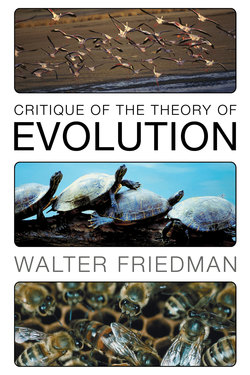Читать книгу Critique of the Theory of Evolution - Walter Friedman - Страница 6
На сайте Литреса книга снята с продажи.
1 : Pseudo-Scientific Methodology
ОглавлениеEvery natural science uses its own methodology to derive conclusions; experimental data either proves that the conclusions are correct or disproves them. Physics and mathematics have, arguably, the most advanced and fruitful methodologies that have withstood the test of time (although mathematics is not a natural science, its methodology meets all the criteria of scientific methodology). Before discussing the methodology that biologists use, it would be beneficial to take a brief look at the methodology commonly used by physicists and chemists.
The science of physics begins with the set of propositions called postulates, or laws of Nature. Examples of postulates include Newton’s laws of motion and Maxwell’s equations of electrodynamics. While postulates themselves are not subjected to experimental verification, certain mathematical manipulations are used to derive conclusions from the postulates. These conclusions are then compared to experimental data. If the conclusions are in agreement with the experimental data then the postulates are correct. For example, you can use Newton’s laws of motion to predict the motion of your car, or the motion of an airplane, or the motion of the Earth around the Sun.
Mathematicians use a similar approach; however, instead of postulates they rely upon what are called axioms.
Biologists take an entirely different approach—they do not have postulates or axioms because they do not need them. Unlike chemistry or physics, which are predictive sciences, biology is a descriptive science. In other words, biology does not make predictions but rather classifies animate objects into categories or classes. Some examples of classes are as follows: mammals, birds, and reptiles. Mammals, for example, could be classified further into subclasses such as feline, bovine, and ape. Species that belong to the same subclass possess certain similarities—in physical appearance, hunting habits, mating habits, and the like. Biological classifications are very advantageous because they allow compact descriptions of huge numbers of species.
So far so good. But proponents of the theory of evolution went much further by suggesting that common characteristics indicate that members of a subclass have common ancestors down the evolutionary line—ancestors that are now deemed to be extinct. This is the so-called concept of macroevolution that forms one of the stepping stones of the evolutionary theory.
Could this same methodology that was used to arrive at the concept macroevolution be applied in other branches of science? Let us try to use such a methodology in chemistry and see what happens.
As the periodic table of elements demonstrates, there are several groups of elements with similar characteristics; examples of such groups include the lanthanide series, the actinide series, and inert gases. If the macroevolution methodology is applied to the groups of elements of the Periodic Table, one inevitably comes to the conclusion that the elements of a group were branched out of the same element as the result of unknown chemical reactions. This “primal element” was completely used up in the series of reactions, so cannot, therefore, be found in the native state any longer. Of course, any chemist would say that this is nonsense. The concept of “primal elements” is completely unscientific. But evolutionists use this faulty methodology to support the concept of macroevolution.
Though some evolutionists saw the weakness of the original concept of macroevolution, they decided to strengthen it by saying that there is no alternative explanation of the fact that certain species have very close characteristics, such as nearly identical genetic structure. This, however, is not correct. There are at least two alternative explanations: 1) Proponents of the hypothesis of alien intervention believe that the Earth’s species were created by extraterrestrial civilization millions of years ago. One might argue that extraterrestrial scientists liked similarities so much that they couldn’t resist the urge to create animals that look and behave alike. 2) A very small number of scientists believe that the universe, and the planet Earth in particular, always existed (this theory originated within Hinduism and was somehow taken up in the sciences). If this theory is correct, scientists would never know why there are unexplainable similarities in animal species.
The concept of macroevolution is based on a faulty logical principle according to which the resemblances among objects indicate a common origin. Centuries ago this principle was deemed to be the foundation of the whole body of science, but currently no one, except for the evolutionists, believes in its validity.
Yet another group of evolutionists decided that the evolutionary theory is a postulate; according to their assertion it does not require experimental proof. But a postulate requires the inference to be subjected to experimental evaluation—if the inference agrees with experimental data then the postulate is correct. So far no one has been able to make a single inference based on the evolutionary theory postulate.
Let us take the most general look at the evolutionists’ logic without referring to any particular science. Suppose you are shown photographs of two men who look pretty much alike and are told that they belong to the same ethnic group, live in the same city, and were born in the same year. You may be tempted to conclude that these men are twins, which could be true; however, this is not the only possible explanation of uncanny resemblance. It could be some sort of genetic coincidence that two unrelated individuals closely resemble one another. There are plenty examples of non-related “twins.”
